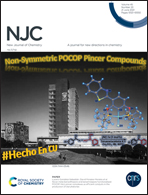Cyclohexyl-substituted non-fullerene small-molecule acceptors for organic solar cells†
Abstract
In this paper, two cyclohexyl-substituted non-fullerene small molecules, T2-Cy6MRH and T2-Cy6PRH, are designed to have the same molecular backbone of a bithiophene (T2) core and rhodanine (RH) end groups. T2-Cy6MRH and T2-Cy6PRH can be synthesized via two and four synthesis steps, respectively, from commercially available starting materials. Thermogravimetric analysis shows that both small molecules are thermally stable at temperatures greater than 380 °C. Compared with T2-Cy6PRH, T2-Cy6MRH exhibits a higher thermal-transition temperature and a more negative enthalpy change, indicating that it exhibits greater crystallinity. Unlike T2-Cy6MRH, T2-Cy6PRH can form a uniform film via solution-processing, because the introduction of longer flexible alkyl chains endows T2-Cy6PRH with better solubility than T2-Cy6MRH. The T2-Cy6PRH film (λmax = 490 nm) exhibits complementary UV-vis absorption with the small-bandgap polymer donor PTB7-Th (λmax = 700 nm). In addition, the highest occupied molecular orbital and the lowest unoccupied molecular orbital energy levels of T2-Cy6PRH are relatively low-lying compared with those of PTB7-Th. An organic solar cell device based on T2-Cy6PRH and PTB7-Th exhibited a power conversion efficiency (PCE) of 4.60% with a high open-circuit voltage of 1.03 V. The addition of [6,6]-phenyl-C61-butyric acid methyl ester substantially improved the device performance, owing to the improved film morphology and the cascade-energy-level alignment, resulting in a PCE of 6.91% under additive- and annealing-free conditions.



 Please wait while we load your content...
Please wait while we load your content...